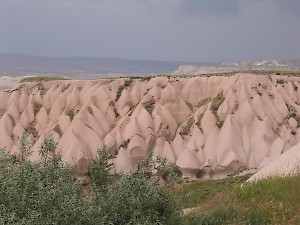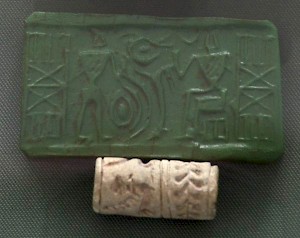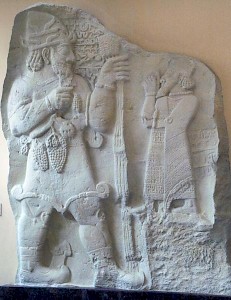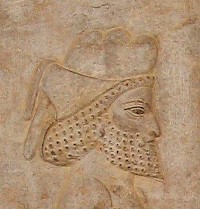Cappadocia
Q217265Cappadocia: ancient name for the country between the rivers Halys and Euphrates, today central Turkey.
Country

Cappadocia is defined as the country between the Black Sea, the Upper Euphrates, the Taurus Mountains, and the river Halys. East of the Euphrates is Armenia; if a traveller crosses the Taurus through the Cilician Gate to the south, he reaches Cilicia; and to the west of the Halys is the country that was known as Phrygia and (later) Galatia. The rocky landscape that is called Cappadocia today, is only a part of the ancient country.
The plain north of the Taurus might be called Cappadocia Proper; it is essentially the land around Mazaca (near modern Kayseri). This country, originally called Tabal, is extremely green and fertile. Greater Cappadocia includes territories to the north, which are sometimes called Paphlagonia and ;Pontus, along the Middle Euphrates, which is called Melitene, and to the west, Lycaonia.
Early History

In the Bronze Age, Cappadocia was the heartland of the empire of the Hittites. The people spoke Luwian. After the collapse of the Hittite world, the inhabitants of Tabal were divided into several small states (e.g. Tyana), loosely held together by the prince of Bit Burutaš, a fort near modern Kululu. Pottery finds prove that these little states had trade contacts with Phrygia, and it appears that the Assyrians watched this economic influence with some suspicion, but during the reign of Sargon II, the two nations concluded an alliance (710/709). Perhaps, the Royal Road between the two capitals, Nineveh and Gordium, dates back to this period.
At the beginning of the seventh century, the Cimmerians invaded Urartu, Cappadocia, and Phrygia. The Phrygian king Midas appears to have been defeated in 696/695 by the invaders and committed suicide. While the Cimmerians settled on the plains of Cappadocia, Midas' kingdom was taken over by a dynasty that was based in Sardes, Lydia. Its king Gyges defeated the Cimmerians in c.665, but was killed in action in 644. However, later Lydian rulers (e.g., Alyattes) warded off the invasion, and started an offensive to the east, gradually approaching Cappadocia.

A similar development started in the east, where the Median tribal federation became increasingly powerful. In 612, the Medes and Babylonians had sacked Nineveh and overthrown the Assyrian Empire; while the Babylonian king Nebukadnezzar was occupied in Syria, the Medes annexed Armenia and proceeded to Cappadocia. On 28 May 585, the armies of the Lydian king Alyattes and the Median leader Cyaxares met in battle, but after a solar eclipse, they decided to conclude a peace treaty. The Halys became the border between the two states; Cappadocia was to be subject to the Medians. Their rule was short-lived, though: in 550/549, they were conquered by the Persian king Cyrus the Great, who went on to invade Anatolia, and in c.547 he conquered Cappadocia and Lydia.
Achaemenid Age

Cappadocia is derived from Old-Persian Katpatuka, the name used by the Achaemenid administration to describe the satrapy beyond the Taurus and Euphrates. According to the Greek researcher Herodotus of Halicarnassus, the Cappadocians (also known as Syrians), together with the Hellespontines, Asian Thracians, Mariandynians, Paphlagonians, Phrygians, belonged to the third tax district and paid a yearly tribute that was worth about 360 talents.note What they had to contribute exactly can perhaps be deduced from the relief on the Eastern Stairs of the Apadana at Persepolis, where the Cappadocian tribute bearer offers a bridled stallion, an overcoat, a coat, and trousers.
The first satrap known by name is one Ariaramnes, who is mentioned by Ctesias of Cnidus as conducting an expedition to Scythia at the beginning of the reign of Darius I the Great (522-486).note Ariaramnes' successors are not known for certain, although a prince named Gobryas commanded the Cappadocians in 480 when Darius' son Xerxes invaded Greece. He was the king's half-brother, which suggests that the Cappadocian unit was of some importance.
We happen to have a description of Cappadocia in Xenophon's Anabasis, which is the history of the civil war between the Persian king Artaxerxes II Mnemon and his brother Cyrus the Younger in 401. From this, we can deduce that the southwestern part of Cappadocia now belonged to a satrapy called Greater Phrygia. We also learn the names of the tribes that lived along the shores of the Black Sea: Mossynoeci, Macrones, Tibarenes, and Paphlagonians. The description gives the impression that control by the central government was not very strong, and this is more or less confirmed by other information: we know that the Cappadocian town of Castabala was an almost independent temple state. On the other hand, in Mazaca was an Iranian fire shrine with Magians, which shows a very strong Persian presence.
During the reign of Artaxerxes II, Cappadocia was divided into two halfs (Paphlagonia and Cappadocia Proper). The satrap of southern Cappadocia, a man named Datames (abridged from Datamithra) played an important role in suppressing a revolt and in a war against the Cadusians. Because of his valor, he was charged with the reconquest of rebellious Egypt, but when he discovered he had insufficient support at the great king's court, Datames decided to return to his satrapy. After the invasion of Egypt, led by Pharnabazus, had failed (373), Datames revolted. His coins show motifs that suggest that he courted native support. He defeated several opponents, cooperated with other rebels (Ariobarzanes in Hellespontine Phrygia; Maussolus in Caria, Orontes in Armenia, Autophradates in Lydia), but was assassinated before 362.
The next satrap known by name is Mithrobuzanes, who was killed in action during the battle at the Granicus (334), in which the Macedonian king Alexander defeated the Persian troops of Asia Minor. Alexander appointed Sabictas as new satrap, but his grip appears to have been weak, because we find a Cappadocian unit (commanded by Ariarathes) fighting in the army of the Achaemenid king Darius III Codomannus during the battle of Gaugamela (331). During Alexander's reign, his officer Antigonus the One-Eyed fought several battles to keep the roads through Cappadocia open.